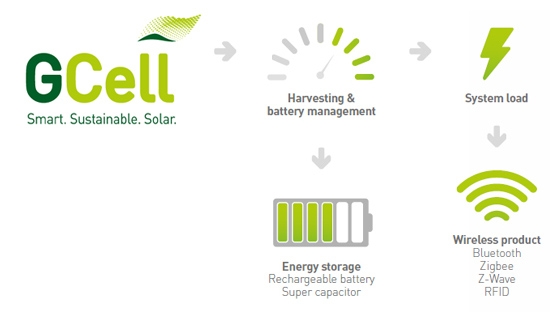Energy storage as part of an Energy Harvesting (EH) system is an important consideration when integrating GCell to your application.
Our engineers are experienced in the design and specification of Energy Harvesting systems with a particular proficiency in pairing energy storage devices with indoor solar modules.
Through continuous professional development they ensure they have a first hand understanding of the latest developments in battery technologies, supercapacitors and other storage options available.

Low Self Discharge Nickel Metal Hydride (LSD NiMH)
LSD NiMH batteries are well suited to product applications with heavy energy usage or in which the GCell function is to extend the product runtime beyond the required product life.
In these products the GCell provides the system standby and light usage and the LSD NiMH batteries provide any heavy system loading. The battery has a low self discharge rate so is well suited to many consumer electronic products which may have long-term shipping or storage.
Advantages
+ Low self discharge rate at around 1% per month
+ Simple / no overcharge protection required
Disadvantages
– Limited form factor for thin products (AAA & AA)
– Poor charging efficiency for low currents (Around 0.01C to fully charge)
– Low single cell voltage of 1.2V
Useful link(s):
Sanyo Eneloop
Lithium Manganese Coin Cells (ML)
ML batteries are very well suited to indoor solar products that have light energy loading. These may be products using GCell in conjunction with electronic displays in Electronic Shelf Labels (ESL) or retail signage (Point of Purchase) applications.
The ML battery has a very good self discharge rate so minimal energy is lost from the battery. The limiting factor for the ML battery is the lower instantaneous discharge current limit. This can limit the use in wireless communication products that require a higher instantaneous discharge current during transmit and receive sequences like Bluetooth and Zigbee.
The battery can be used in conjunction with Super Capacitors to improve the discharge performance, but the system cost and overall leakage needs to be considered.
Advantages
+ Low self discharge rate at 2-5% per year
+ Low minimum charge acceptance at 10uA and greater (capacity dependant)
+ High single cell voltage of 3V
+ Coin cells can be suitable for think product applications
Disadvantages
– Limited capacities (100mAh maximum)
– Poor instantaneous discharge for high currents (200uA standard discharge)
Lithium Ion Phosphate (LifePO4)
LiFePO4 batteries are well suited to many medium to light load usage application in conjunction with GCell modules.
In comparison to Lithium Polymer and Lithium Ion, LiFePO4 have a higher cycle life and maximum instantaneous discharge current rate. They have a lower energy density which results in a bigger form factor for like-for-like capacity comparisons, but they have the advantage of a lower self discharge rate and increased safety over other comparable lithium battery types.
Advantages
+ Lower self discharge rate at 1.5 to 2% per month
+ Good instantaneous discharge at around 5C
+ High cycle life at 2000 cycles
+ Uses more environmentally friendly materials
+ Greater stability and safety in comparison to other lithium batteries
+ Many form factors available
Disadvantages
– Lower energy density than Lithium Polymer (Around 14% lower)
– Patent approved or licensed cathode material need to be used to avoid patent infringement
Useful link(s):
McNair Technology Company
FPC Lithium-Ceramic Battery (FLCB)
 FLCB is a solid state battery technology that is manufactured based on Flexible Printed Circuit (FPC) manufacturing process and base materials. The battery is flexible and can be combined with the GCell in thin or flexible product applications.
Advantages
+ Ultra thin at around 0.35mm
+ Flexible and bendable
+ Safe during puncture or folding
Disadvantages
– Lower energy density compared to other established battery technologies
– Self discharge rate of around 5% per month
– Commercial products are available from only one company
Useful link(s):
Prologium
Thin-Film Solid State Batteries
Solid state batteries are an emerging battery technology. They are well suited to EH applications as they can be charged in very low light conditions by the GCell. They also have a very high cycle life due to using a solid state electrolyte.
Being a new battery technology the cost in relatively high in comparison to other commercially available battery types.
Advantages
+ Very low charge acceptance (100nA)
+ High cycle life at 100,000 cycles
+ Low profile
Disadvantages
– Only small capacities are available
– Technology is relatively new so cost is high in comparison to other established technologies
Useful link(s):
Cymbet
GS Nanotech
Infinite Power Solutions (IPS)
Supercapacitors
Supercapacitors are very well suited to energy harvesting applications by GCell modules where the energy storage acts as a buffer to cover peak system loads. The high cycle life of Super Capacitors also makes them most suitable for applications where a continual charge and discharge cycle is required.
Advantages
+ Excellent instantaneous discharge rate
+ Very high cycle life (200K cycles plus)
+ Good minimum charge acceptance of around 35uA
Disadvantages
– High self discharge rate of 2-5uA stabilised
– Lower energy density due to linear discharge profile
Useful link(s):
AVX
CAPXX
Maxwell Technologies

